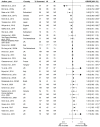Sex Disparities in Cardiovascular Risk Factor Assessment and Screening for Diabetes-Related Complications in Individuals With Diabetes: A Systematic Review
- PMID: 33859615
- PMCID: PMC8043152
- DOI: 10.3389/fendo.2021.617902
Sex Disparities in Cardiovascular Risk Factor Assessment and Screening for Diabetes-Related Complications in Individuals With Diabetes: A Systematic Review
Abstract
Background: Insight in sex disparities in the detection of cardiovascular risk factors and diabetes-related complications may improve diabetes care. The aim of this systematic review is to study whether sex disparities exist in the assessment of cardiovascular risk factors and screening for diabetes-related complications.
Methods: PubMed was systematically searched up to April 2020, followed by manual reference screening and citations checks (snowballing) using Google Scholar. Observational studies were included if they reported on the assessment of cardiovascular risk factors (HbA1c, lipids, blood pressure, smoking status, or BMI) and/or screening for nephropathy, retinopathy, or performance of feet examinations, in men and women with diabetes separately. Studies adjusting their analyses for at least age, or when age was considered as a covariable but left out from the final analyses for various reasons (i.e. backward selection), were included for qualitative analyses. No meta-analyses were planned because substantial heterogeneity between studies was expected. A modified Newcastle-Ottawa Quality Assessment Scale for cohort studies was used to assess risk of bias.
Results: Overall, 81 studies were included. The majority of the included studies were from Europe or North America (84%).The number of individuals per study ranged from 200 to 3,135,019 and data were extracted from various data sources in a variety of settings. Screening rates varied considerably across studies. For example, screening rates for retinopathy ranged from 13% to 90%, with half the studies reporting screening rates less than 50%. Mixed findings were found regarding the presence, magnitude, and direction of sex disparities with regard to the assessment of cardiovascular risk factors and screening for diabetes-related complications, with some evidence suggesting that women, compared with men, may be more likely to receive retinopathy screening and less likely to receive foot exams.
Conclusion: Overall, no consistent pattern favoring men or women was found with regard to the assessment of cardiovascular risk factors and screening for diabetes-related complications, and screening rates can be improved for both sexes.
Keywords: diabetes; diabetes-related complications; healthcare provision; risk factors; screening; sex disparities; systematic review.
Copyright © 2021 de Jong, Peters, de Ritter, van der Kallen, Sep, Woodward, Stehouwer, Bots and Vos.
Conflict of interest statement
The authors declare that the research was conducted in the absence of any commercial or financial relationships that could be construed as a potential conflict of interest.
Figures










Similar articles
-
Folic acid supplementation and malaria susceptibility and severity among people taking antifolate antimalarial drugs in endemic areas.Cochrane Database Syst Rev. 2022 Feb 1;2(2022):CD014217. doi: 10.1002/14651858.CD014217. Cochrane Database Syst Rev. 2022. PMID: 36321557 Free PMC article.
-
Behavioral and Pharmacotherapy Weight Loss Interventions to Prevent Obesity-Related Morbidity and Mortality in Adults: An Updated Systematic Review for the U.S. Preventive Services Task Force [Internet].Rockville (MD): Agency for Healthcare Research and Quality (US); 2018 Sep. Report No.: 18-05239-EF-1. Rockville (MD): Agency for Healthcare Research and Quality (US); 2018 Sep. Report No.: 18-05239-EF-1. PMID: 30354042 Free Books & Documents. Review.
-
Prognostic factors for the development and progression of proliferative diabetic retinopathy in people with diabetic retinopathy.Cochrane Database Syst Rev. 2023 Feb 22;2(2):CD013775. doi: 10.1002/14651858.CD013775.pub2. Cochrane Database Syst Rev. 2023. PMID: 36815723 Free PMC article. Review.
-
Screening for High Blood Pressure in Adults: A Systematic Evidence Review for the U.S. Preventive Services Task Force [Internet].Rockville (MD): Agency for Healthcare Research and Quality (US); 2014 Dec. Report No.: 13-05194-EF-1. Rockville (MD): Agency for Healthcare Research and Quality (US); 2014 Dec. Report No.: 13-05194-EF-1. PMID: 25632496 Free Books & Documents. Review.
-
Diabetes as a risk factor for incident peripheral arterial disease in women compared to men: a systematic review and meta-analysis.Cardiovasc Diabetol. 2020 Sep 26;19(1):151. doi: 10.1186/s12933-020-01130-4. Cardiovasc Diabetol. 2020. PMID: 32979922 Free PMC article.
Cited by
-
Heart failure in diabetes.Metabolism. 2021 Dec;125:154910. doi: 10.1016/j.metabol.2021.154910. Epub 2021 Oct 8. Metabolism. 2021. PMID: 34627874 Free PMC article. Review.
-
Deep learning algorithms to detect diabetic kidney disease from retinal photographs in multiethnic populations with diabetes.J Am Med Inform Assoc. 2023 Nov 17;30(12):1904-1914. doi: 10.1093/jamia/ocad179. J Am Med Inform Assoc. 2023. PMID: 37659103 Free PMC article.
-
Less Timely Initiation of Glucose-Lowering Medication Among Younger and Male Patients With Diabetes and Similar Initiation of Blood Pressure-Lowering Medication Across Age and Sex: Trends Between 2015 and 2020.Front Pharmacol. 2022 May 12;13:883103. doi: 10.3389/fphar.2022.883103. eCollection 2022. Front Pharmacol. 2022. PMID: 35645811 Free PMC article.
References
-
- IDF . Atlas 9th edition International Diabetes Federation; 2019. Available at: https://diabetesatlas.org/en/resources/.
-
- Peters SAE, Huxley RR, Woodward M. Diabetes as risk factor for incident coronary heart disease in women compared with men: a systematic review and meta-analysis of 64 cohorts including 858,507 individuals and 28,203 coronary events. Diabetologia (2014) 57:1542–51. 10.1007/s00125-014-3260-6 - DOI - PubMed
Publication types
MeSH terms
Grants and funding
LinkOut - more resources
Full Text Sources
Other Literature Sources
Medical
Miscellaneous

